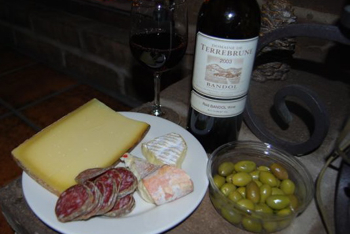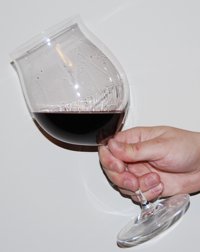|
Dry Red Wine
What are Dry Red Wines?Dry red wine is wine made predominantly from red grape varieties which has been fermented to dryness, meaning it has little or no residual sugar in the bottled wine. Like other dry wines in general, all the sugar in the grapes have been fermented completely to alcohol.Most red wines are dry, with the exception being some dessert styles of red wine such as Port. Most red table wines, such as Cabernet Sauvignon, Merlot, Zinfandel, Pinot Noir, Syrah and wines from these grapes such as Bordeaux and Burgundy, are completely dry. Red table wine can vary from light fruity wines to rich, full-bodied wines and everything in between. The particular style is a function of the wine growing region, the grapes used, the winemaking style and other factors. An important thing to remember is that calling a wine dry simply means it has little or no sugar in it. However, tannins, naturally occurring compounds in grapes which are common in red wines and contribute to the structure and texture of the wine, are often described as drying or making your mouth feel dry. While it is ok to describe such a wine as dry, being tannic and being dry (not having sugar) are really two quite different things. For example, a Port dessert wine can be quite sweet (and therefore not a dry red wine) yet still have considerable tannins in their flavor and mouthfeel. Also learn about Rosé Wines and Dry White Wines. What Do They Taste Like and What Foods Do You Eat with Them?Most typical red table wines are dry. As mentioned above, they vary considerably. Whereas a good young Beaujolais from France may be light-bodied, fresh and fruity, a great, young Bordeaux (made mostly from blends of Cabernet Sauvignon, Merlot, Cabernet Franc and other grapes) can be quite large-scaled with big rich, deep, dark flavors and considerable tannin. Somewhere in the middle, Pinot Noir based wines such as red Burgundies are generally less tannic and muscular than Bordeaux with a silkier texture, finer tannins and higher acidity and brightness.As you can see, there is a whole world of dry red wine out there with various styles and flavors so it is hard to generalize. Also, in addition to the effect of tannins mentioned above, dry wines can vary in how dry the seem even if they have essentially zero residual sugar. While some may seem sweeter if they are very ripe with lower acid, a less fruity wine with higher acid and earthy flavors may seem more drying. This does not mean that the wine has any different amount of alcohol, just that the other flavors (fruity, acid, tannin, etc.) vary in their intensity.  Dry red wines are often very good with food if you pair them wisely. In general, try to pair things in terms of their flavors and intensity. Pair lighter red wines with lighter fare and heartier wines with richer, meaty foods. A big rich Cabernet Sauvignon with a perfectly grilled steak is a classic pairing. For more tips and ideas about pairing red wines with food, check out our Food and Wine Pairing section! Return to the Types of Wine page.  |







